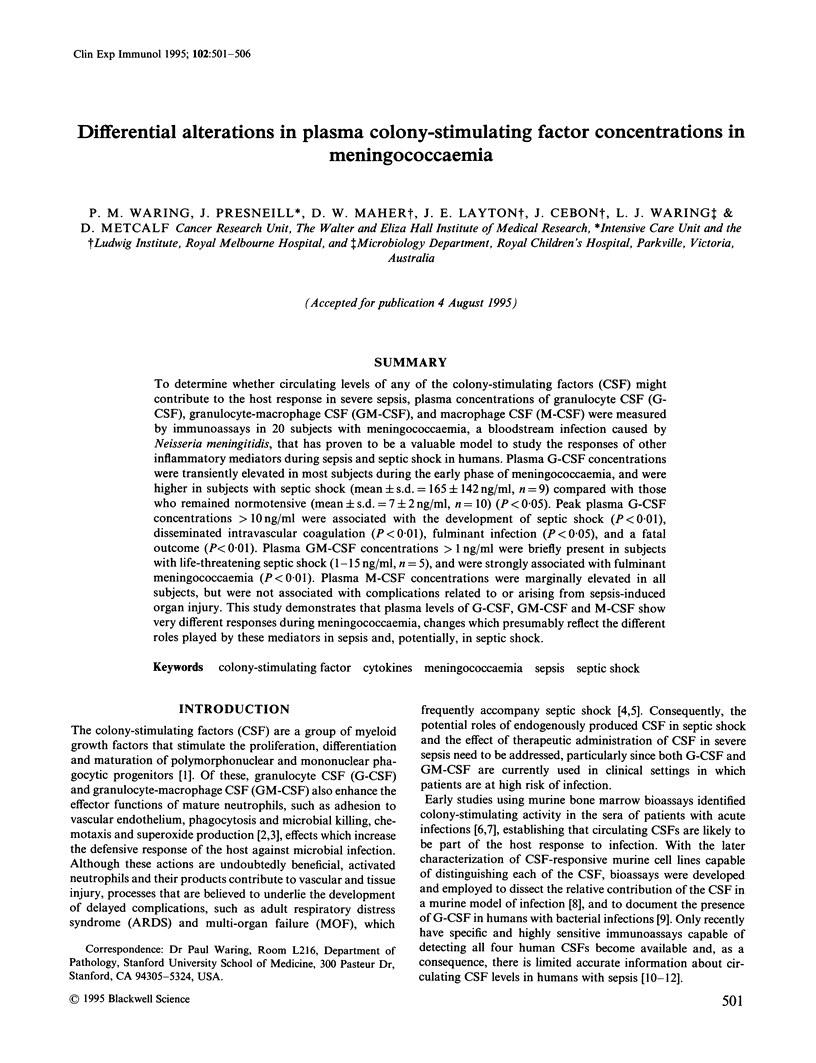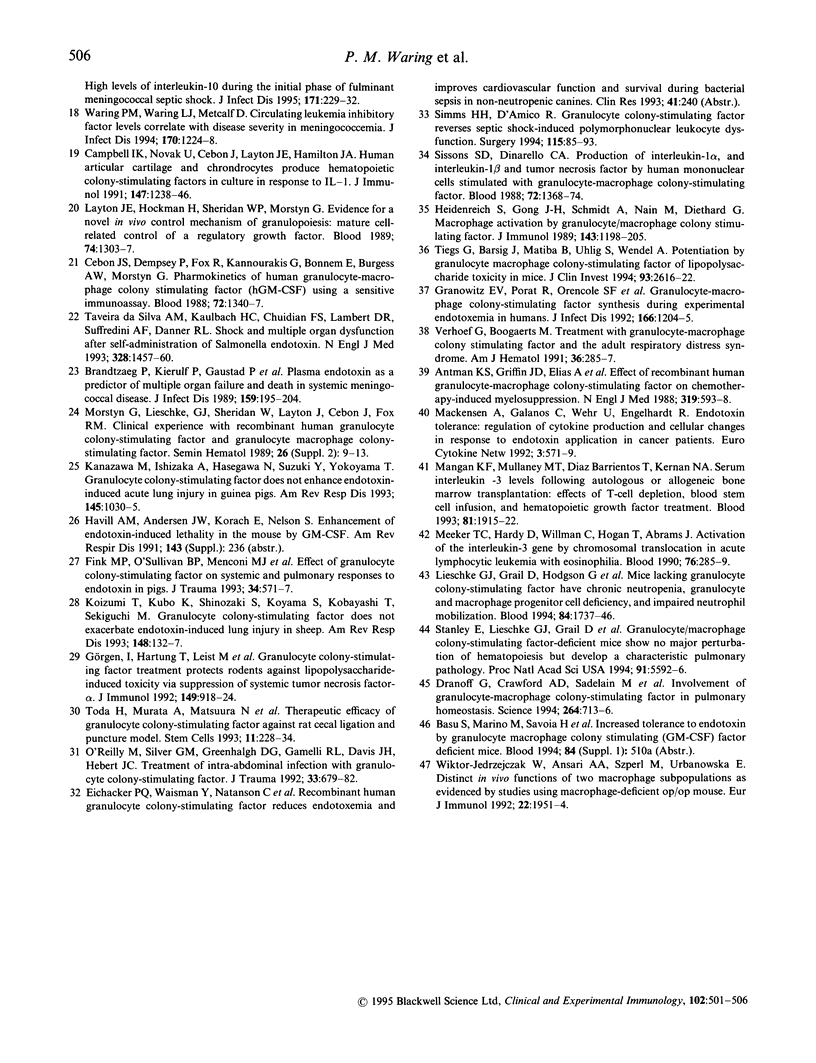Abstract
To determine whether circulating levels of any of the colony-stimulating factors (CSF) might contribute to the host response in severe sepsis, plasma concentrations of granulocyte CSF (G-CSF), granulocyte-macrophage CSF (GM-CSF), and macrophage CSF (M-CSF) were measured by immunoassays in 20 subjects with meningococcaemia, a bloodstream infection caused by Neisseria meningitidis, that has proven to be a valuable model to study the responses of other inflammatory mediators during sepsis and septic shock in humans. Plasma G-CSF concentrations were transiently elevated in most subjects during the early phase of meningococcaemia, and were higher in subjects with septic shock (mean +/- s.d. = 165 +/- 142 ng/ml, n = 9) compared with those who remained normotensive (mean +/- s.d. = 7 +/- 2 ng/ml, n = 10) (P < 0.05). Peak plasma G-CSF concentrations > 10 ng/ml were associated with the development of septic shock (P < 0.01), disseminated intravascular coagulation (P < 0.01), fulminant infection (P < 0.05), and a fatal outcome (P < 0.01). Plasma GM-CSF concentrations > 1 ng/ml were briefly present in subjects with life-threatening septic shock (1-15 ng/ml, n = 5), and were strongly associated with fulminant meningococcaemia (P < 0.01). Plasma M-CSF concentrations were marginally elevated in all subjects, but were not associated with complications related to or arising from sepsis-induced organ injury. This study demonstrates that plasma levels of G-CSF, GM-CSF and M-CSF show very different responses during meningococcaemia, changes which presumably reflect the different roles played by these mediators in sepsis and, potentially, in septic shock.
Full text
PDF





Selected References
These references are in PubMed. This may not be the complete list of references from this article.
- Antman K. S., Griffin J. D., Elias A., Socinski M. A., Ryan L., Cannistra S. A., Oette D., Whitley M., Frei E., 3rd, Schnipper L. E. Effect of recombinant human granulocyte-macrophage colony-stimulating factor on chemotherapy-induced myelosuppression. N Engl J Med. 1988 Sep 8;319(10):593–598. doi: 10.1056/NEJM198809083191001. [DOI] [PubMed] [Google Scholar]
- Brandtzaeg P., Kierulf P., Gaustad P., Skulberg A., Bruun J. N., Halvorsen S., Sørensen E. Plasma endotoxin as a predictor of multiple organ failure and death in systemic meningococcal disease. J Infect Dis. 1989 Feb;159(2):195–204. doi: 10.1093/infdis/159.2.195. [DOI] [PubMed] [Google Scholar]
- Campbell I. K., Novak U., Cebon J., Layton J. E., Hamilton J. A. Human articular cartilage and chondrocytes produce hemopoietic colony-stimulating factors in culture in response to IL-1. J Immunol. 1991 Aug 15;147(4):1238–1246. [PubMed] [Google Scholar]
- Cebon J., Dempsey P., Fox R., Kannourakis G., Bonnem E., Burgess A. W., Morstyn G. Pharmacokinetics of human granulocyte-macrophage colony-stimulating factor using a sensitive immunoassay. Blood. 1988 Oct;72(4):1340–1347. [PubMed] [Google Scholar]
- Cebon J., Layton J. E., Maher D., Morstyn G. Endogenous haemopoietic growth factors in neutropenia and infection. Br J Haematol. 1994 Feb;86(2):265–274. doi: 10.1111/j.1365-2141.1994.tb04725.x. [DOI] [PubMed] [Google Scholar]
- Cheers C., Haigh A. M., Kelso A., Metcalf D., Stanley E. R., Young A. M. Production of colony-stimulating factors (CSFs) during infection: separate determinations of macrophage-, granulocyte-, granulocyte-macrophage-, and multi-CSFs. Infect Immun. 1988 Jan;56(1):247–251. doi: 10.1128/iai.56.1.247-251.1988. [DOI] [PMC free article] [PubMed] [Google Scholar]
- Deitch E. A. Multiple organ failure. Pathophysiology and potential future therapy. Ann Surg. 1992 Aug;216(2):117–134. doi: 10.1097/00000658-199208000-00002. [DOI] [PMC free article] [PubMed] [Google Scholar]
- Dranoff G., Crawford A. D., Sadelain M., Ream B., Rashid A., Bronson R. T., Dickersin G. R., Bachurski C. J., Mark E. L., Whitsett J. A. Involvement of granulocyte-macrophage colony-stimulating factor in pulmonary homeostasis. Science. 1994 Apr 29;264(5159):713–716. doi: 10.1126/science.8171324. [DOI] [PubMed] [Google Scholar]
- Fink M. P., O'Sullivan B. P., Menconi M. J., Wollert S. P., Wang H., Youssef M. E., Bellelsle J. M. Effect of granulocyte colony-stimulating factor on systemic and pulmonary responses to endotoxin in pigs. J Trauma. 1993 Apr;34(4):571–578. doi: 10.1097/00005373-199304000-00015. [DOI] [PubMed] [Google Scholar]
- Foster R., Jr, Metcalf D., Robinson W. A., Bradley T. R. Bone marrow colony stimulating activity in human sera. Results of two independent surveys in Buffalo and Melbourne. Br J Haematol. 1968 Aug;15(2):147–159. doi: 10.1111/j.1365-2141.1968.tb01524.x. [DOI] [PubMed] [Google Scholar]
- Gasson J. C. Molecular physiology of granulocyte-macrophage colony-stimulating factor. Blood. 1991 Mar 15;77(6):1131–1145. [PubMed] [Google Scholar]
- Girardin E., Grau G. E., Dayer J. M., Roux-Lombard P., Lambert P. H. Tumor necrosis factor and interleukin-1 in the serum of children with severe infectious purpura. N Engl J Med. 1988 Aug 18;319(7):397–400. doi: 10.1056/NEJM198808183190703. [DOI] [PubMed] [Google Scholar]
- Granowitz E. V., Porat R., Orencole S. F., Callahan M. V., Lynch E. A., Wolff S. M., Dinarello C. A. Granulocyte-macrophage colony-stimulating factor synthesis during experimental endotoxemia in humans. J Infect Dis. 1992 Nov;166(5):1204–1205. doi: 10.1093/infdis/166.5.1204. [DOI] [PubMed] [Google Scholar]
- Görgen I., Hartung T., Leist M., Niehörster M., Tiegs G., Uhlig S., Weitzel F., Wendel A. Granulocyte colony-stimulating factor treatment protects rodents against lipopolysaccharide-induced toxicity via suppression of systemic tumor necrosis factor-alpha. J Immunol. 1992 Aug 1;149(3):918–924. [PubMed] [Google Scholar]
- Halstensen A., Ceska M., Brandtzaeg P., Redl H., Naess A., Waage A. Interleukin-8 in serum and cerebrospinal fluid from patients with meningococcal disease. J Infect Dis. 1993 Feb;167(2):471–475. doi: 10.1093/infdis/167.2.471. [DOI] [PubMed] [Google Scholar]
- Heidenreich S., Gong J. H., Schmidt A., Nain M., Gemsa D. Macrophage activation by granulocyte/macrophage colony-stimulating factor. Priming for enhanced release of tumor necrosis factor-alpha and prostaglandin E2. J Immunol. 1989 Aug 15;143(4):1198–1205. [PubMed] [Google Scholar]
- Kanazawa M., Ishizaka A., Hasegawa N., Suzuki Y., Yokoyama T. Granulocyte colony-stimulating factor does not enhance endotoxin-induced acute lung injury in guinea pigs. Am Rev Respir Dis. 1992 May;145(5):1030–1035. doi: 10.1164/ajrccm/145.5.1030. [DOI] [PubMed] [Google Scholar]
- Kawakami M., Tsutsumi H., Kumakawa T., Abe H., Hirai M., Kurosawa S., Mori M., Fukushima M. Levels of serum granulocyte colony-stimulating factor in patients with infections. Blood. 1990 Nov 15;76(10):1962–1964. [PubMed] [Google Scholar]
- Koizumi T., Kubo K., Shinozaki S., Koyama S., Kobayashi T., Sekiguchi M. Granulocyte colony-stimulating factor does not exacerbate endotoxin-induced lung injury in sheep. Am Rev Respir Dis. 1993 Jul;148(1):132–137. doi: 10.1164/ajrccm/148.1.132. [DOI] [PubMed] [Google Scholar]
- Layton J. E. Granulocyte colony-stimulating factor: structure, function and physiology. Growth Factors. 1992;6(3):179–186. doi: 10.3109/08977199209026924. [DOI] [PubMed] [Google Scholar]
- Layton J. E., Hockman H., Sheridan W. P., Morstyn G. Evidence for a novel in vivo control mechanism of granulopoiesis: mature cell-related control of a regulatory growth factor. Blood. 1989 Sep;74(4):1303–1307. [PubMed] [Google Scholar]
- Lieschke G. J., Grail D., Hodgson G., Metcalf D., Stanley E., Cheers C., Fowler K. J., Basu S., Zhan Y. F., Dunn A. R. Mice lacking granulocyte colony-stimulating factor have chronic neutropenia, granulocyte and macrophage progenitor cell deficiency, and impaired neutrophil mobilization. Blood. 1994 Sep 15;84(6):1737–1746. [PubMed] [Google Scholar]
- Mackensen A., Galanos C., Wehr U., Engelhardt R. Endotoxin tolerance: regulation of cytokine production and cellular changes in response to endotoxin application in cancer patients. Eur Cytokine Netw. 1992 Nov-Dec;3(6):571–579. [PubMed] [Google Scholar]
- Mangan K. F., Mullaney M. T., Barrientos T. D., Kernan N. A. Serum interleukin-3 levels following autologous or allogeneic bone marrow transplantation: effects of T-cell depletion, blood stem cell infusion, and hematopoietic growth factor treatment. Blood. 1993 Apr 1;81(7):1915–1922. [PubMed] [Google Scholar]
- Meeker T. C., Hardy D., Willman C., Hogan T., Abrams J. Activation of the interleukin-3 gene by chromosome translocation in acute lymphocytic leukemia with eosinophilia. Blood. 1990 Jul 15;76(2):285–289. [PubMed] [Google Scholar]
- Metcalf D. Control of granulocytes and macrophages: molecular, cellular, and clinical aspects. Science. 1991 Oct 25;254(5031):529–533. doi: 10.1126/science.1948028. [DOI] [PubMed] [Google Scholar]
- Metcalf D. Induction of differentiation in murine myelomonocytic leukemia cells by the serum of patients with acute myeloid leukemia and other diseases. Int J Cancer. 1981 May 15;27(5):577–584. doi: 10.1002/ijc.2910270503. [DOI] [PubMed] [Google Scholar]
- Metcalf D., Wahren B. Bone marrow colony-stimulating activity of sera in infectious mononucleosis. Br Med J. 1968 Jul 13;3(5610):99–101. doi: 10.1136/bmj.3.5610.99. [DOI] [PMC free article] [PubMed] [Google Scholar]
- Morstyn G., Lieschke G. J., Sheridan W., Layton J., Cebon J., Fox R. M. Clinical experience with recombinant human granulocyte colony-stimulating factor and granulocyte macrophage colony-stimulating factor. Semin Hematol. 1989 Apr;26(2 Suppl 2):9–13. [PubMed] [Google Scholar]
- O'Reilly M., Silver G. M., Greenhalgh D. G., Gamelli R. L., Davis J. H., Hebert J. C. Treatment of intra-abdominal infection with granulocyte colony-stimulating factor. J Trauma. 1992 Nov;33(5):679–682. doi: 10.1097/00005373-199211000-00014. [DOI] [PubMed] [Google Scholar]
- Simms H. H., D'Amico R. Granulocyte colony-stimulating factor reverses septic shock-induced polymorphonuclear leukocyte dysfunction. Surgery. 1994 Jan;115(1):85–93. [PubMed] [Google Scholar]
- Sisson S. D., Dinarello C. A. Production of interleukin-1 alpha, interleukin-1 beta and tumor necrosis factor by human mononuclear cells stimulated with granulocyte-macrophage colony-stimulating factor. Blood. 1988 Oct;72(4):1368–1374. [PubMed] [Google Scholar]
- Stanley E., Lieschke G. J., Grail D., Metcalf D., Hodgson G., Gall J. A., Maher D. W., Cebon J., Sinickas V., Dunn A. R. Granulocyte/macrophage colony-stimulating factor-deficient mice show no major perturbation of hematopoiesis but develop a characteristic pulmonary pathology. Proc Natl Acad Sci U S A. 1994 Jun 7;91(12):5592–5596. doi: 10.1073/pnas.91.12.5592. [DOI] [PMC free article] [PubMed] [Google Scholar]
- Stefano J. L., Abbasi S., Pearlman S. A., Spear M. L., Esterly K. L., Bhutani V. K. Closure of the ductus arteriosus with indomethacin in ventilated neonates with respiratory distress syndrome. Effects of pulmonary compliance and ventilation. Am Rev Respir Dis. 1991 Feb;143(2):236–239. doi: 10.1164/ajrccm/143.2.236. [DOI] [PubMed] [Google Scholar]
- Taveira da Silva A. M., Kaulbach H. C., Chuidian F. S., Lambert D. R., Suffredini A. F., Danner R. L. Brief report: shock and multiple-organ dysfunction after self-administration of Salmonella endotoxin. N Engl J Med. 1993 May 20;328(20):1457–1460. doi: 10.1056/NEJM199305203282005. [DOI] [PubMed] [Google Scholar]
- Tiegs G., Barsig J., Matiba B., Uhlig S., Wendel A. Potentiation by granulocyte macrophage colony-stimulating factor of lipopolysaccharide toxicity in mice. J Clin Invest. 1994 Jun;93(6):2616–2622. doi: 10.1172/JCI117274. [DOI] [PMC free article] [PubMed] [Google Scholar]
- Toda H., Murata A., Matsuura N., Uda K., Oka Y., Tanaka N., Mori T. Therapeutic efficacy of granulocyte colony stimulating factor against rat cecal ligation and puncture model. Stem Cells. 1993 May;11(3):228–234. doi: 10.1002/stem.5530110310. [DOI] [PubMed] [Google Scholar]
- Verhoef G., Boogaerts M. Treatment with granulocyte-macrophage colony stimulating factor and the adult respiratory distress syndrome. Am J Hematol. 1991 Apr;36(4):285–287. doi: 10.1002/ajh.2830360413. [DOI] [PubMed] [Google Scholar]
- Waage A., Brandtzaeg P., Halstensen A., Kierulf P., Espevik T. The complex pattern of cytokines in serum from patients with meningococcal septic shock. Association between interleukin 6, interleukin 1, and fatal outcome. J Exp Med. 1989 Jan 1;169(1):333–338. doi: 10.1084/jem.169.1.333. [DOI] [PMC free article] [PubMed] [Google Scholar]
- Waage A., Halstensen A., Espevik T. Association between tumour necrosis factor in serum and fatal outcome in patients with meningococcal disease. Lancet. 1987 Feb 14;1(8529):355–357. doi: 10.1016/s0140-6736(87)91728-4. [DOI] [PubMed] [Google Scholar]
- Waring P. M., Waring L. J., Metcalf D. Circulating leukemia inhibitory factor levels correlate with disease severity in meningococcemia. J Infect Dis. 1994 Nov;170(5):1224–1228. doi: 10.1093/infdis/170.5.1224. [DOI] [PubMed] [Google Scholar]
- Watari K., Asano S., Shirafuji N., Kodo H., Ozawa K., Takaku F., Kamachi S. Serum granulocyte colony-stimulating factor levels in healthy volunteers and patients with various disorders as estimated by enzyme immunoassay. Blood. 1989 Jan;73(1):117–122. [PubMed] [Google Scholar]
- Wiktor-Jedrzejczak W., Ansari A. A., Szperl M., Urbanowska E. Distinct in vivo functions of two macrophage subpopulations as evidenced by studies using macrophage-deficient op/op mouse. Eur J Immunol. 1992 Jul;22(7):1951–1954. doi: 10.1002/eji.1830220743. [DOI] [PubMed] [Google Scholar]
- Zimmerman J. J., Ringer T. V. Inflammatory host responses in sepsis. Crit Care Clin. 1992 Jan;8(1):163–189. [PubMed] [Google Scholar]


